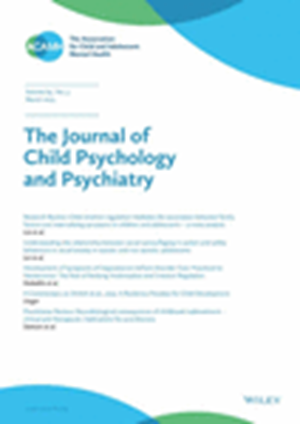Annual Research Review: Early conduct problems - precursors, outcomes, and etiology.
IF 7
1区 医学
Q1 PSYCHIATRY
引用次数: 0
Abstract
During the toddler and preschool period, nearly all children engage in some level of aggression, defiance, stealing, and temper tantrums. While the frequency and intensity of these behaviors tends to decrease across early childhood, a subset of children engage in these conduct problem behaviors at a higher intensity early in life and/or do not desist from these behaviors. Instead, these behaviors escalate across childhood and adolescence into serious forms of antisocial behavior (e.g., aggression, rule breaking). Given the negative impacts of these behaviors on children engaging in them, victims, and society, childhood conduct problems are a major public health concern. Here, we provide an updated review of the research identifying the trajectory of conduct problems; risk factors for their emergence, persistence, and escalation; and mechanisms through which risk impacts behavior, using a biopsychosocial and ecological lens. We describe how child and parent attributes contribute to a coercive dyadic cycle that leads to escalating problem behaviors, and how the broader context undermines these proximal relationships to increase risk for conduct problems. Next, we consider the role that genetics plays in these processes and describe how gene-environment interplay shapes early conduct problems. Further, we describe the ways in which these environmental and genetic risk processes impact brain development to increase risk for conduct problems. Finally, we discuss recent approaches to prevent and treat conduct problems and discuss research needs to better support our understanding of the development, prevention, and treatment of early conduct problems.年度研究回顾:早期行为问题-前兆,结果和病因。
在蹒跚学步和学龄前时期,几乎所有的孩子都会有不同程度的攻击、挑衅、偷窃和发脾气的行为。虽然这些行为的频率和强度在儿童早期趋于减少,但有一部分儿童在生命早期从事这些行为问题行为的强度更高,并且/或者不会停止这些行为。相反,这些行为在童年和青春期升级为严重的反社会行为(例如,攻击,破坏规则)。鉴于这些行为对参与其中的儿童、受害者和社会的负面影响,儿童行为问题是一个主要的公共卫生问题。在这里,我们提供了一个最新的研究综述,确定行为问题的轨迹;导致其出现、持续和升级的风险因素;以及风险影响行为的机制,使用生物心理社会和生态的视角。我们描述了孩子和父母的属性如何促成一个强制性的二元循环,导致问题行为升级,以及更广泛的背景如何破坏这些近端关系,增加行为问题的风险。接下来,我们将考虑遗传学在这些过程中所起的作用,并描述基因-环境相互作用如何形成早期行为问题。此外,我们描述了这些环境和遗传风险过程影响大脑发育的方式,以增加行为问题的风险。最后,我们讨论了预防和治疗行为问题的最新方法,并讨论了研究需求,以更好地支持我们对早期行为问题的发展、预防和治疗的理解。
本文章由计算机程序翻译,如有差异,请以英文原文为准。
求助全文
约1分钟内获得全文
求助全文
来源期刊
CiteScore
13.80
自引率
5.30%
发文量
169
审稿时长
1 months
期刊介绍:
The Journal of Child Psychology and Psychiatry (JCPP) is a highly regarded international publication that focuses on the fields of child and adolescent psychology and psychiatry. It is recognized for publishing top-tier, clinically relevant research across various disciplines related to these areas. JCPP has a broad global readership and covers a diverse range of topics, including:
Epidemiology: Studies on the prevalence and distribution of mental health issues in children and adolescents.
Diagnosis: Research on the identification and classification of childhood disorders.
Treatments: Psychotherapeutic and psychopharmacological interventions for child and adolescent mental health.
Behavior and Cognition: Studies on the behavioral and cognitive aspects of childhood disorders.
Neuroscience and Neurobiology: Research on the neural and biological underpinnings of child mental health.
Genetics: Genetic factors contributing to the development of childhood disorders.
JCPP serves as a platform for integrating empirical research, clinical studies, and high-quality reviews from diverse perspectives, theoretical viewpoints, and disciplines. This interdisciplinary approach is a key feature of the journal, as it fosters a comprehensive understanding of child and adolescent mental health.
The Journal of Child Psychology and Psychiatry is published 12 times a year and is affiliated with the Association for Child and Adolescent Mental Health (ACAMH), which supports the journal's mission to advance knowledge and practice in the field of child and adolescent mental health.

 求助内容:
求助内容: 应助结果提醒方式:
应助结果提醒方式:


